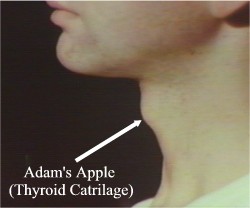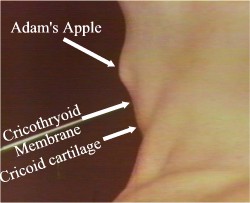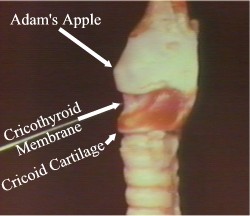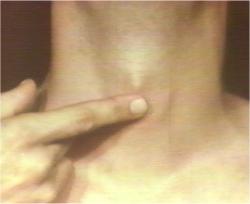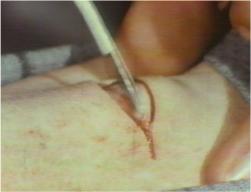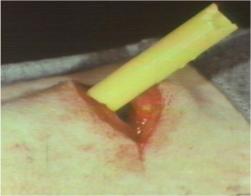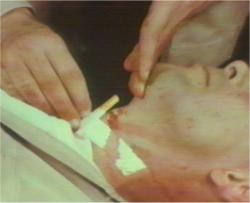|
|
||||
CricothyroidotomyOften, the safest and fastest method to establish a surgical airway is to perform a cricothyroidotomy. In this procedure, the cricothyroid membrane is opened to allow air to pass through into the trachea.. The cricothyroid membrane is the soft spot just below the Adam's apple (thyroid cartilage) and just above the cricoid cartilage. In men, this is easily identified by running your finger down the center of the neck. Just beyond the Adam's apple is a small, soft indentation about the width of your finger. This is the cricothyroid membrane. The thyroid cartilage (Adam's apple) in women is not usually as prominent as it is in men. It is easier to find their cricothyroid membrane by sliding your finger up the midline of the neck to the first hard bump. That is the cricoid cartilage. Above it is the cricothyroid membrane (your target), and above the membrane is the thyroid cartilage. Practicing identifying the cricothyroid membrane in your own neck, and in other personnel. Then, in an emergency, you will have no difficulty finding it. To perform an emergency cricothyroidotomy, you need a sharp instrument, such as a:
Ideally, this procedure is performed by well-trained and experienced medical personnel, using sterile technique and instruments designed for this purpose. In other than ideal conditions, speed is more important than sterile technique, special instruments or experience. In an operational setting, if the casualty needs a surgical airway, go ahead an do it, and do it quickly. Some of the most successful airway rescues have been performed by inexperienced, minimally-trained personnel, who have never done this before. There typically won't be time for any anesthetic, but that's not normally and issue since the people on whom you would be doing this procedure will be unconscious. Bleeding usually isn't a big problem. There are no large blood vessels either in the skin or beneath the skin in this area.
Ideally, this hollow tube would be an endotracheal tube, but any tube-like structure will work fine. Examples include:
Whatever device you use to keep the airway open, try to find some adhesive tape to hold it in place, without obstructing air flow. An emergency cricothyroidotomy can be left in place for up to 72 hours, but after that, it should be replaced by a tracheostomy, placed lower in the trachea by trained surgeons.
This section was developed from A1701-70-0750V "Emergency Airway." Health Sciences Media Division, US Army Medical Department C&S, Fort Sam Houston, Texas
Home · Military Medicine · Sick Call · Basic Exams · Medical Procedures · Lab and X-ray · The Pharmacy · The Library · Equipment · Patient Transport · Medical Force Protection · Operational Safety · Operational Settings · Special Operations · Humanitarian Missions · Instructions/Orders · Other Agencies · Video Gallery · Forms · Web Links · Acknowledgements · Help · Feedback Approved for public release; Distribution is unlimited.
*This web version is provided by The Brookside Associates, LLC. It contains original contents from the official US Navy NAVMED P-5139, but has been reformatted for web access and includes advertising and links that were not present in the original version. The medical information presented was reviewed and felt to be accurate in 2001. Medical knowledge and practice methods may have changed since that time. Some links may no longer be active. This web version has not been approved by the Department of the Navy or the Department of Defense. The presence of any advertising on these pages does not constitute an endorsement of that product or service by either the US Department of Defense or the Brookside Associates. The Brookside Associates is a private organization, not affiliated with the United States Department of Defense.
© 2015, Brookside Associates, LLC. All rights reserved |
|
|||

